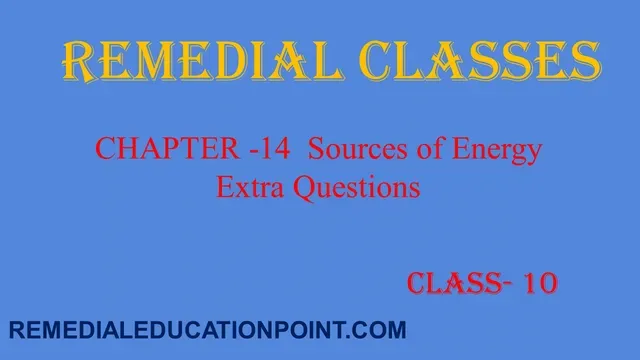In this post, you will read about Class 10 Science Chapter 14 Extra Questions
Physics. In Class
10 Science Chapter 14 Extra Questions, you will find extra questions
for better practice that will help you in your board exams.
Class 10 Science Chapter 14 Extra Questions
 |
| Class 10 Science Chapter 14 Extra Questions |
Class 10 Science Chapter 14 Extra Questions
Class 10 Science
Chapter 14 Extra Questions consist of topics- good source of energy, conventional
and non-conventional sources of energy, renewable and non-renewable sources of
energy, fossil fuels like- coal, petroleum, natural gas, advantages of energy
from fossil fuel, thermal power plants, hydroelectrically energy, disadvantages
of fossil fuel, Geothermal energy- advantages and disadvantages, solar energy-
solar cell and solar panel. Biomass, biogas- its components and formation,
If you find any difficulty in finding answers to Class 10 Science Chapter 14 Extra Questions then go through NCERT solutions of class 10 science or you can comment in the comment section, we will be very pleased to help you.
CHAPTER- 14- SOURCES OF ENERGY
1. What is a good source of energy?
2. What is a good fuel?
3. Windmill is environmentally friendly. Explain
[Annual exam-2012]
4. (i). write the name of the metal used for the fabrication of solar cells.[Annual exam-2012]
(ii). Write the name of the heavy atom used for producing nuclear energy.
5. Mention the names of any two types of fossil
fuel.[Annual exam-2013]
6. What are the characteristics of good sources
of energy.[Annual exam-2013]
7. Write the different forms of energy.
8. How is fossil fuel harmful to the environment?
9. Name some conventional sources of energy?
10. Name some non-conventional sources of energy?
11. What is fossil fuel? What are the
disadvantages of fossil fuels?
12. What is a thermal power plant?
13. What is a hydropower plant? What are the
limitations of it?
14. What is biomass?
15. What is the main constituent of biogas
(gobar gas)? Describe the structure of the biogas plant with a diagram and its
works?
16. Why biogas is also called gobar gas?
17. How much methane is present in biogas?
18. Write the advantages of biogas (gobar gas).
19. How is the air generated? Or how is wind blow?
20. Describe the wind energy. Draw the diagram of a windmill.
21. Which country is called the country of winds?
22. What are the limitations of wind energy?
23. How can charcoal be produced? Why is it good
to convert wood into charcoal?
24. How has the traditional use of wind and water
energy been modified for our convenience?
25. Draw the diagram of the solar cooker? Describe its
structure also.
26. What do you mean by a solar constant?
27. What is a solar panel?
28. Which metalloid (semiconductor) is used to
make solar cells?
29. How much electricity is produced by a solar
cell?
30. What are the uses of solar energy?
31. What are the limitations of solar energy
(solar cell / solar panel)?
32. Name the various forms of energy obtained from
oceans?
33. What do you mean by high and low tides?
34. What is nuclear energy? What are the
disadvantages of nuclear energy?
35. What is nuclear fusion?
36. Name any two renewable sources of energy.
37. What is nuclear fission?
38. On what principle is hydrogen bomb based?
39. Write two types of energy that are not
related to solar energy.
40. What are the advantages of nuclear energy?
41. What is geothermal energy?
42. What is hydroelectricity?
43. Name two energy sources that you would
consider to be renewable. Give reason.
44. Name two energy sources that you would
consider to be exhaustible. Give reason.
45. Name the compound in which the slurry left
behind in the digester is rich.
46. What are the limitations of the energy that
can be obtained from the oceans?
47. What was the most common source of heat energy
in ancient times?
48. Where has the largest wind farm been
established in India?
49. Name the nuclear reaction which is a source of
energy in the sun and the other stars.
50. On which nuclear reaction is a nuclear bomb
based?
51. A solar cell transforms the energy of one form
into another form. What are these two forms of energy?
52. What are the conditions needed for nuclear
fusion?
53. How can the pollution caused by the burning of
fossil fuels be reduced?
54. What kind of mirror- concave, convex, or plane
mirror would be best for a solar cooker? Why?
55. What is the minimum wind velocity required to obtain
electricity?
56. What are hot spots?
57. Write the advantages and disadvantages of
solar cells.
58. Which two elements are used in the fabrication
of a solar cell?
59. Name the heavy elements used in nuclear
fission?
60. Name two dams whose construction was a matter
of controversy.
61. What are the uses of solar energy?
62. How electricity is generated from the following and write the limitations also.
i. Ocean thermal energy
ii. Geothermal energy
iii. Nuclear energy
63. Write the full form of –
i. CNG
ii. LPG
64. Write the equation of the fusion of hydrogen atoms
to form a helium atom.
65. Write the value of the solar constant at the
surface of the earth.
66. Hydrogen has been used as rocket fuel. Would
you consider it is a cleaner fuel than CNG? Why or why not?
67. What is the maximum amount of energy that
could be received at one square meter on the earth’s surface?
68. Name the main constituents of biogas.
69. What are renewable sources of energy? Give two
examples.
70. What are non-renewable sources of energy? Give
two examples.
71. Name the process by which fossil fuels formed.
72. Where natural gas is generally found?
73. How charcoal is formed? Name the process used.




No comments:
Post a Comment